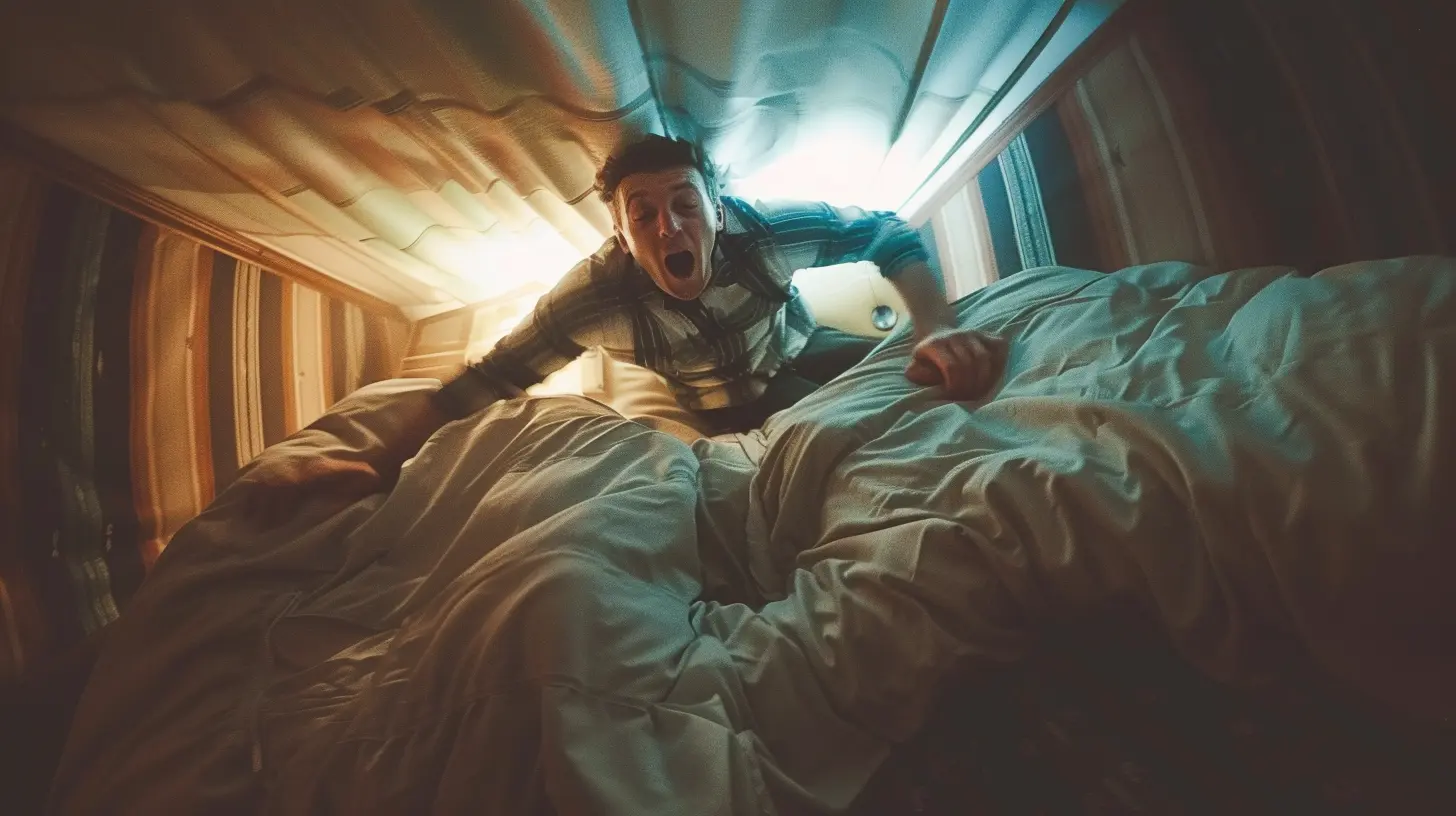The Dangers of Sleepwalking and How to Keep Safe
22 July 2025
Have you ever woken up in a completely different room than where you fell asleep? Or maybe you’ve noticed your partner wandering around the house at 3 a.m., completely unaware of their surroundings? If so, you’re not alone—and you might be dealing with sleepwalking.
Sleepwalking might sound like something cute or funny you see in cartoons, but in reality, it can be dangerous. It’s more than just walking around while still asleep. It's a sleep disorder that can lead to serious accidents and raise safety concerns not just for the sleepwalker, but for everyone in the household.
In this article, we’ll break down what sleepwalking really is, the underlying causes, the dangers it presents, and most importantly—how to keep yourself or a loved one safe. So, grab a cozy blanket (and maybe double-check your front door's locked), and let's talk about this nighttime mystery.
What Is Sleepwalking, Really?
Sleepwalking, also known as somnambulism, is a type of parasomnia—a group of sleep disorders that involve abnormal behavior during sleep. It usually happens during the deeper stages of non-REM (Rapid Eye Movement) sleep, typically in the first third of the night. That means someone could be sleepwalking within an hour or two of falling asleep.Common Sleepwalking Behaviors:
- Getting out of bed and walking around- Sitting up with a blank stare
- Talking or mumbling incoherently
- Performing routine activities like dressing, eating, or even driving (!)
- Urinating in unusual places
- Attempting to leave the house
Sounds creepy, right? And yes, it's just as real as it sounds.
Who Sleepwalks?
It’s more common than you think. According to studies, up to 17% of children sleepwalk at some point, while about 4% of adults experience it too. Kids are more prone to it and usually grow out of it. But for adults, sleepwalking can have more serious implications, especially when it happens regularly.Some people are just wired that way—if you’ve got a family history of sleepwalking, chances are higher you might do it too. It’s not rare to hear someone say, “Yeah, my dad used to do that too.”
What Causes Sleepwalking?
It isn’t as simple as “they’re just a deep sleeper.” Sleepwalking can stem from a number of issues, and it often doesn’t have just one cause.Common Triggers:
- Sleep deprivation: Ironically, not getting enough sleep can make you sleepwalk.- Stress and anxiety: Your brain might be on overdrive even when your body wants to rest.
- Sleep disorders: Conditions like sleep apnea or restless leg syndrome can mess with your sleep architecture.
- Alcohol or drug use: These can disrupt your natural sleep cycle and make parasomnias more likely.
- Medications: Especially sedatives or hypnotics.
- Fever or illness: Particularly in children, a high temperature can trigger sleepwalking episodes.
So, no—it’s not just about being weird at night. There's usually an underlying cause that needs some attention.
The Real Dangers of Sleepwalking
People often joke about sleepwalking, but let’s get real—it can be downright dangerous. Your brain is asleep, but your body is on the move. That's a recipe for trouble.1. Accidental Injuries
Imagine trying to cook a meal or climb stairs with your eyes half-shut and your brain offline. Yikes. Sleepwalkers might:- Trip over furniture
- Fall down stairs
- Walk into walls or doors
- Burn themselves
- Step on sharp objects
I've heard stories of people climbing out of windows or attempting to drive—all without being aware. That’s not something to laugh off.
2. Getting Lost
Sleepwalkers have been found blocks away from their homes with no memory of how they got there. Especially in adults, this is a huge concern for those living in unfamiliar places like hotels or dorms.3. Danger to Others
If a sleepwalker becomes startled, they might lash out—especially when someone tries to wake them. This can create dangerous situations for partners or roommates.4. Emotional Toll
Living with or being a sleepwalker can cause a lot of anxiety. People often feel embarrassed or frightened by their actions, and loss of trust in their own safety can lead to chronic stress or depression.Bottom line: it's not just a quirky nighttime behavior. It's a safety hazard that needs to be dealt with seriously.
How to Stay Safe: Sleepwalking Safety Tips
So, what can you do if you or someone you love sleepwalks? Good news—you don’t have to just “deal with it.” There are tons of practical steps to help make your environment safer and reduce episodes.1. Create a Sleep-Safe Environment
Treat your bedroom like a toddler-proof zone. Sounds funny, but it works.- Lock windows and doors (keep the keys out of reach)
- Install safety gates near stairs
- Clear the floor of clutter
- Remove sharp objects or breakables
- Use nightlights to prevent stumbling in the dark
Even small changes can prevent big injuries.
2. Establish a Consistent Sleep Routine
Sleepwalkers often have disrupted sleep cycles. Going to bed and waking up at the same time every day helps regulate your body's internal clock, making episodes less likely.And don’t skimp on sleep. A well-rested brain is less likely to go rogue at night.
3. Manage Stress
Let’s be real—modern life is just stressful. But practicing mindfulness, journaling, or doing some light yoga before bed can help calm your mind before you hit the pillow.Don’t like yoga? Even a warm bath or listening to relaxing music can help you wind down.
4. Avoid Triggers
Things like alcohol, caffeine, and certain medications can make sleepwalking worse. If you suspect something you’re taking is contributing to the problem, talk to your doctor. They might be able to switch you to something else.5. Don’t Wake a Sleepwalker (Unless You Have To)
The old myth says you should never wake a sleepwalker. That’s mostly true. Waking them suddenly can cause disorientation, panic, or even aggression.Instead, gently guide them back to bed if it’s safe to do so. If they're about to hurt themselves—yes, definitely intervene, but try to do it as gently as possible.
6. Use Alarms or Motion Detectors
Yep, we live in the future. With smart home tech, you can set up alarms, door sensors, or even motion-activated lights to alert you when someone’s wandering around at night. This can be a real game-changer for families dealing with frequent sleepwalking.7. Medical Help? Definitely an Option
If sleepwalking is happening regularly or leading to injuries, it’s time to talk to a doctor or sleep specialist. You might need a sleep study or other assessments to see what’s going on.In some cases, medications or cognitive behavioral therapy (CBT) can really help reduce episodes.
Living with a Sleepwalker: Tips for Families and Roommates
If you're sharing space with a sleepwalker, it can be nerve-wracking. Here's how to support them—and protect both of you at the same time.- Have open conversations about it. No shame, no blame.
- Work together to make the home safer.
- Stay calm during an episode.
- Keep a sleep diary to help identify triggers.
- Encourage them to seek medical help if it’s happening often.
Final Thoughts: It’s Manageable—With The Right Steps
Sleepwalking can be scary—to experience and to witness. But it's not a hopeless situation.Understanding what causes it and implementing the right precautions can make a huge difference. Whether it’s tweaking your bedtime routine, making your bedroom safer, or getting professional help, there’s always something you can do to make sleepwalking less of a nightmare.
And remember—if you or someone you know is dealing with this, support, patience, and a little bit of humor can go a long way.
Sleep tight… and stay in bed, okay?
all images in this post were generated using AI tools
Category:
Sleep HealthAuthor:

Tiffany Foster
Discussion
rate this article
1 comments
Sorin Harris
Sleepwalking poses significant risks, including injury and accidents. Understanding the triggers and implementing safety measures, such as securing your home and maintaining a consistent sleep schedule, can mitigate dangers. Awareness and education are key to protecting sleepwalkers and ensuring a safe sleeping environment for everyone.
August 9, 2025 at 4:57 AM

Tiffany Foster
Thank you for highlighting the importance of safety measures and awareness in addressing sleepwalking risks. Your points on understanding triggers and securing the home are essential for protecting sleepwalkers.


